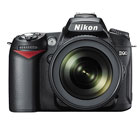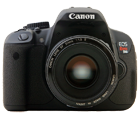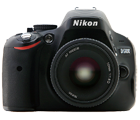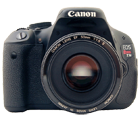Digital SLR Camera Types |
Page updated: January 2009 |
A few short years ago, there was only one type of digital SLR you could get your hands on: those with sensors smaller than a standard frame of 35mm film.
I'll go into more depth in just a moment about these cropped sensor SLRs, but first a revelation: today there are five different types of digital SLR cameras in the marketplace.
While presenting consumers with more alternatives, the different "styles" of digital SLRs can also lead to a lot of additional confusion.
This page helps to break down the five different digital SLR camera types currently available, and explains the defining feature of each one.
SLR Type 1 - Cropped Sensor
The vast majority of the digital SLR cameras available today fall into this category.
Here's the high-level introduction:
These digital SLR cameras have sensors that are smaller than a frame of 35mm film.
Those just making their first leap into the world of digital SLR cameras need not be overly concerned about this, since it primarily affects those who have used film SLR cameras in the past.
The net effect of a cropped sensor is this: the same lens used on a film SLR won't capture the exact same image when it's used on a digital SLR.
Since the digital sensor is physically smaller than a frame of film, the digital SLR captures LESS of the image that passes through the lens - this crops out part of the image and result in an artificial zoom effect.
The amount of scenery you're able to see when looking through the camera's viewfinder is directly related to a property of the lens called focal length.
- Lenses with short focal lengths (between 10 and 20mm) allow you to see a lot of scenery which is why they are also called wide angle lenses
- Lenses with medium focal lengths (between 50 and 100mm) capture a pretty standard view of the world which is why they're called standard lenses
- Lenses with long focal lengths (between 200 and 600mm) are used to get up close and personal with subjects that are far away and are called telephoto lenses
The reason that I just spun off into a brief introduction to lens focal lengths is because when you use any film lens on a digital SLR with a cropped sensor, you're going to have to take the focal length multiplier into account.
An example:
- You're using a digital SLR camera with a cropped sensor, and a 1.6x focal length multiplier
- A standard 50mm lens captures images more like an 80mm lens when used on this camera (50 x 1.6 = 80)
The exact same multiplier can be used with every lens that you attach to the camera: a 100mm lens frames more like a 160mm lens, while a 300mm lens frames like a 480mm lens.
Since I have an entire page that discusses the impact of crop factor, I won't go into any more detail here.
For the purpose of this page, it's important for you to understand that virtually all digital SLR cameras (as of 2008) fall into this category.
Popular entry-level cameras like the Canon Rebel XSi and the Nikon D60 both have cropped sensors, but even higher-end cameras like the Canon 40D and Pentax K20D also have them.
SLR Type 2 - Full-Frame Sensor
The second digital SLR camera type makes sense once you understand the concepts of crop factor and focal length multiplier.
Full-frame DSLRs have sensors that are virtually the same size as 35mm film.
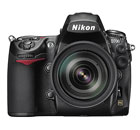
While you might have already guessed the end result, here it is: a full-frame digital SLR has NO crop factor, or a focal length multiplier of one.
A 50mm lens on a full frame digital SLR captures scenery just like a 50mm lens on a film SLR camera.
Besides preventing you from pulling out a calculator constantly to determine the "true" focal length of your lens, full-frame SLRs come with another benefit: higher image quality.
In the world of digital sensors, size does matter and bigger is better.
The most noticeable improvement in image quality with a larger sensor is reduced noise at high ISO. Even though most digital SLR sensors are cropped, they are still larger than the sensors in compact digicams.
This is why the low-light performance of a digital SLR is significantly better than that of a compact camera.
Images taken at ISO 800 on a compact digital camera are a mess of colored pixels, while ISO 800 images taken with an SLR are sometimes hard to tell from ISO 100.
If cropped frame sensors can handle noise so well, imagine what a full-frame SLR can pull off.
| Read more about full-frame digital SLR cameras |
SLR Type 3 - 4/3rds
When Olympus first starting releasing their current line of "E" digital SLR cameras, they did so under the banner of a new standard: something called the 4/3rds system.
The idea behind the 4/3rds SLR system was simple:
Cameras that use the 4/3 system can use ANY 4/3rds lens, regardless of the manufacturer.
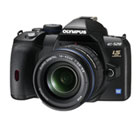
Prior to this, lens compatibility was pretty much a one-to-one relationship between the company that made the camera and the one that made the lens.
For example, if you bought a Pentax digital SLR, then you'd have to get a Pentax lens to go with it to ensure compatibility. A Canon digitial SLR worked best with a Canon lens attached.
The 4/3rds system attempts to do away with all of this and ensures that any 4/3rds lens will work with any 4/3rds camera.
For a long time, Olympus was the only company adopting the standard and making cameras and lenses that were compatible with 4/3rds. Now both Olympus and Panasonic (who've become partners) develop them.
Recently Panasonic has gone down a new path with this technology, and I'll get to that in just a moment.
The main advantage that 4/3rds digital SLRs have over the others is that they are smaller and weigh less. In fact, the cameras made by Olympus are some of the smallest and lightest digital SLRs on the market today.
4/3rds lenses are also quite light, without sacrificing image quality in the process.
If the idea of an incredibly small sized digital SLR is appealing to you, then you just need to be aware of two things:
- The 4/3rds sensor doesn't have the same aspect ratio as other (more common) sensors, and this will affect how your photos print
- 4/3rds sensors are smaller than ones that aren't, resulting in a more significant crop factor (all 4/3rds SLRs have a focal length multiplier of 2x)
SLR Type 4 - Micro 4/3
To be precise, a micro 4/3rds camera is NOT a digital SLR.
The letters SLR stand for Single Lens Reflex, and the "reflex" part of the name means that inside the camera there's a mirror that reflects light up to the viewfinder.
The end result of a reflex system is that you see exactly what the lens sees (which allows you to track even a fast-moving subject through the viewfinder).
Micro 4/3rds digital cameras don't include the same optical viewfinder that's part of every digital SLR camera.
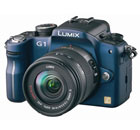
Instead, they replace the entire optical system with something called an electronic viewfinder (or EVF). The EVF is like a tiny television set inside the viewfinder that broadcasts the image being captured by the sensor.
However, the big difference between compact cameras and Micro 4/3rds cameras is that you CAN change the lenses on a Micro 4/3rds camera.
Essentially, these cameras are hybrids: they have the compact size and very low weight of a compact camera, but they also have the multiple lenses and higher image quality of an SLR.
Currently, only Olympus and Panasonic are developing cameras that fall into the Micro 4/3rds category, and their hope is that these cameras act as a bridge for all those people out there with compact cameras who are indimidated by the size, weight and features of an SLR.
| Read more about Micro 4/3rds cameras |
SLR Type 5 - Video/Still Cameras
Not long ago, every digital SLR was missing one feature that is now quite common on every compact camera: the ability to capture video.
This was no real suprise to the community of existing SLR users, but it often came as a real shock to people who "upgraded" from a compact camera only to find out that their new SLR was missing this feature.
There are two main reasons why SLRs lacked video for such a long time:
- SLR purists argued that there was no reason for them to capture video - SLRs were precision instruments for capturing stills and need not be blended with the hundreds of capable video cameras already available
- On the technical side, the companies had to find a way to bypass the reflex mirror (an integral component of an SLR camera) and needed to fully develop live mode first
Live view mode (the ability to preview an image on the camera's LCD before you take it) paved the way for the introduction of video.
The very first digital SLR camera to include a video mode was the Nikon D90, followed closely by the Canon EOS 5D Mark II (both released in 2008).
While the D90 is for the consumer market, the 5D Mark II (in both features and price) is more for professional and semi-professional photographers.
The unique aspect of capturing video with a digital SLR rather than a conventional video camera is also what sets SLRs apart from compact digital cameras: the ability to change lenses.
Now you can capture videos with extreme wide angle lenses and extreme telephoto lenses. You can capture video of tiny insects with a macro lens.
And the video captured by these cameras is not limited to a tiny format only suitable for display on your computer. Both the D90 and the 5D Mark II capture High-Definition (HD) widescreen video, which can then be played back on a modern flatscreen TV.
To make it even more obvious that a TV is the intended display medium, both cameras include an HDMI port. HDMI stands for High-Definition Multimedia Interface and it's a new way of transferring a digital video and audio signal from a output device (like a DVD player, video camera, game console, etc.) to your television set.
When you connect camera to TV with a special HDMI cable, you're maximizing the quality of the audio and video captured by the camera.
As we get into 2009 and 2010, expect to see many more digital SLR cameras with HDMI ports that are able to capture both video and stills.
| Read more about video digital SLR cameras |
Related Links
| Digital SLR Home | Full-Frame Digital SLRs |
